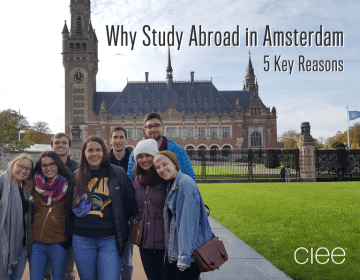Asia vs. Europe Travel: Which is Better for Study Abroad?
Choosing between Asia vs. Europe as the backdrop of your study abroad experience can be quite a challenging decision! Each continent offers unforgettable cultural experiences, immersive academic opportunities, and life-changing personal growth prospects.
In this blog post, we’ll explore the key aspects of studying abroad in Europe vs. Asia, providing you with the insights necessary to help you make an informed decision.
Let’s dig in!
Quick Overview: Asia vs. Europe Travel Abroad
If you’re wondering, “Asia vs. Europe, which is better?” we’ll be honest: They’re both incredible! Truthfully, you can’t go wrong either way. European vs. Asian study abroad journeys offer equally undeniable pros including experiencing vibrant cultures, visiting world-famous landmarks, sampling divine cuisines, and taking courses at top-tier institutions.
Let’s look at each region in closer depth to better compare the two.
Asia
Asia is a vast continent known for its rich cultural heritage, rapid economic growth, and diverse landscapes. Countries like China, Japan, South Korea, Singapore, Australia, and New Zealand are popular destinations for study abroad programs year after year, and CIEE Study Abroad offers tons of programs in all five places! Additionally, Asia's top educational institutions, such as Yonsei University, Singapore Management University, and the University of Sydney, rank highly on global scales, attracting students worldwide.
Studying abroad in Asia offers the chance to immerse yourself in the history of ancient traditions while also appreciating the future through cutting-edge modernity. From the bustling cities of Shanghai and Tokyo to the jaw-dropping landscapes of Taipei and Seoul, Asia provides a unique blend of experiences. Whether you spend your time exploring centuries-old temples or visiting vibrant night markets, there are endless ways to make the most of Asia study abroad while benefiting from the region’s advanced technological infrastructures and innovative learning environments.

Read More: Top 5 Places to Study Abroad in the Asia-Pacific Region
Europe
Europe has long been a favored destination for international students, offering plenty of historical significance, architectural marvels, and cultural heritage. Countries like England, Ireland, Germany, France, and Italy are renowned for their prestigious universities, including Trinity College Dublin and the University of Westminster. Europe’s educational institutions are celebrated for their academic excellence, research opportunities, and cultural diversity.
Studying abroad in Europe means living in the heart of Western history and culture. CIEE Study Abroad offers programs in 12 European countries, making it possible for you to visit iconic landmarks like the Eiffel Tower, the Colosseum, and the Berlin Wall, while enjoying a rich cultural tapestry of art, music, and literature. Additionally, Europe's compact geography makes it easy to travel between countries, allowing you to experience a variety of cultures and languages in a short period.

Asia vs. Europe
Ultimately, choosing between Asia and Europe for your study abroad experience depends on factors like your personal interests, academic goals, and cultural preferences. Asia offers a dynamic environment with a focus on innovation and tradition, ideal for students interested in radically different cultural practices. Europe, with its long-standing academic institutions and rich cultural heritage, is perfect for those who value historical context and academic prestige.
At the end of the day, both regions offer unique advantages: Asia's affordability and modernity, and Europe's accessibility and cultural richness. The best choice for you will be the one that aligns with your goals, budget, and desired experiences.
Read More: The Ultimate Travel Guide to Europe for College Students
Fast Facts about Asia Study Abroad
To help you make the right decision in the Asia vs. Europe study abroad debate, consider a few key details about what studying abroad in Asia would be like.
- Population: Approximately 4.8 billion
- Climate: Southeastern Asia is typically mild to hot whereas northeastern areas can be cold and East Asia is more temperate
- Top Cities: Tokyo, Seoul, Kyoto, Taipei, and Shanghai
- Top Languages: Chinese, Japanese, and Korean
- Busiest Airports: Tokyo-Haneda International Airport, Shanghai Pudong International Airport, and Incheon International Airport
- Top Attractions: Great Wall of China, Mount Fuji, and Gyeongbokgung Palace
- Bonus Fact: More than 60% of the world’s population lives in Asia
Asia Travel Tips
Traveling in Asia can be an exhilarating adventure, offering a blend of ancient history and contemporary excitement. Here are some essential tips to help you navigate and enjoy your time in Asia:
- Embrace Local Customs and Etiquette: Each country in Asia has its own set of customs and traditions. Researching local etiquette, such as bowing in Japan or removing shoes before entering homes in Korea, will help you show respect and integrate smoothly.
- Respect Cultural Sensitivities: Asia is home to diverse religions and traditions. Dress modestly when visiting religious sites, ask for permission before taking photos of people, and respect local practices and beliefs.
- Stay Connected: Ensure you have a reliable internet connection. Purchasing a local SIM card or a portable Wi-Fi device can help you stay connected, navigate unfamiliar places, and keep in touch with friends and family.
- Explore Beyond Major Cities: While cities like Singapore and Shanghai are exciting, don't miss the opportunity to explore lesser-known destinations. Rural areas, small towns, and natural wonders often offer unique cultural experiences and breathtaking scenery.
- Try Local Cuisine: Food is a central part of Asian cultures. Be adventurous and try local dishes, but also be mindful of food allergies and dietary restrictions. Street food can be delicious and safe if you choose stalls with high turnover.

Top 3 Asia Study Abroad Programs
Now that you’ve familiarized yourself with Asia study abroad, consider three of CIEE’s top programs in the Asia-Pacific region:
Featured Program #1: Seoul Arts + Sciences
Designed for students who wish to learn at a top-ranked Korean university and experience everyday life in Seoul, this program invites you to study Korean language, architecture, engineering, computer science, international relations, and more.
- Program Length: 17 weeks
- Credit: 15-18 semester hours/22.5-27 quarter hours
- Eligibility: 2.5 overall GPA
- Featured Course: Intercultural Communication and Leadership
- Featured Excursion: Visit the notorious Korean Demilitarized Zone
Read More: Study Abroad in South Korea: The Ultimate Guide
Featured Program #2: Tokyo Arts + Sciences
Take your arts and sciences studies to the next level in Japan's exciting capital, Tokyo, which radiates light, energy, anime, manga, and games. Earn credits in anthropology, art history, cultural studies, history, international business, economics, religion, and more while exploring the fascinating, sprawling, and densely populated city.
- Program Length: 18 weeks
- Credit: 15-16 semester hours/22.5-24 quarter hours
- Eligibility: 2.8 overall GPA
- Featured Course: Intercultural Communication and Leadership
- Featured Excursion: Find your inner peace in an authentic Zen garden
Read More: How to Study Abroad in Japan (4 Simple Steps)
Featured Program #3: Shanghai China in a Global Context
Accelerate your Mandarin skills and gain an in-depth understanding of China while studying abroad in Shanghai, one of the fastest-growing cities in in the world! This program is perfect for students interested in learning about the colonial history, foreign policy, political development, and social issues that have given rise to modern China.
- Program Length: 15 weeks
- Credit: 15 semester hours/22.5 quarter hours
- Eligibility: 2.5 overall GPA
- Featured Course: Modern Chinese History
- Featured Excursion: Visit Nanjing, one of China’s four ancient capitals and major commercial centers

Read More: 3 Best Cities for Study Abroad in Greater China
Fast Facts about Europe Study Abroad
Now that you’ve learned about Asia, let’s compare Asia vs. Europe population, Asian vs. European culture, and other interesting facts!
- Population: Approximately 741.6 million
- Climate: Europe's climate is diverse, ranging from the temperate maritime climate of Western Europe to the continental climate of Eastern Europe and the Mediterranean climate of Southern Europe
- Top Cities: London, Berlin, Madrid, Rome, and Paris
- Top Languages: German, French, and Italian
- Busiest Airports: Heathrow Airport, Charles de Gaulle Airport, and Amsterdam Airport Schiphol
- Top Attractions: Eiffel Tower, La Sagrada Familia, and the Colosseum
- Bonus Fact: Europe is home to 400+ UNESCO World Heritage Sites
Europe Travel Tips
Traveling in Europe offers a rich tapestry of history, culture, and modernity. Here are some tips to help you make the most of your European adventure:
- Travel Light and Efficiently: Europe’s extensive public transportation network makes it easy to travel between cities and countries. Use trains and budget airlines to explore different regions efficiently. Pack light to navigate easily through crowded stations and streets.
- Stay Safe and Aware: Europe is generally safe, but it's important to stay vigilant, especially in crowded tourist areas. Keep an eye on your belongings, travel with buddies as much as possible, and be cautious with your personal information.
- Take Advantage of Student Discounts: Many European countries offer discounts on transportation, museums, and cultural sites for students. Carry your student ID and inquire about discounts wherever you go.
- Learn Key Phrases: English is widely spoken but knowing a few phrases in the local language can enhance your interactions and show respect for the local culture. Simple greetings and polite expressions are always appreciated.
- Respect Historical Sites: Europe is home to many historical landmarks. Follow guidelines and respect the preservation efforts of these sites. Avoid touching artifacts and stay within designated areas.

Top 3 Europe Study Abroad Programs
Now that you know more about Europe study abroad, explore three of CIEE’s top programs across the region:
Featured Program #1: Barcelona Business + Culture
Take your studies to Barcelona, one of Europe’s most dynamic startup ecosystems and leaders in innovation and entrepreneurship. Designed for students with a background in business, this program invites you to take courses in marketing, economics, management, finance, and more while marveling at the city’s world-class landmarks.
- Program Length: 14 weeks
- Credit: 14-18 semester hours/21-25.5 quarter hours
- Eligibility: 2.5 overall GPA
- Featured Course: The Spanish Economy in the European Union
- Featured Excursion: Discover the Gràcia neighborhood, famous for its bohemian and artistic style and streets filled with color and culture
Read More: Your Guide to the Ultimate Barcelona Study Abroad Experience
Featured Program #2: Prague Central European Studies
Designed for students interested in gaining an in-depth understanding of the Czech Republic, this program invites you to take courses at CIEE Prague and at CIEE’s esteemed partner schools Charles University and the Academy of Performing Arts. Outside the classroom, you’ll take a field trip to Auschwitz, participate in a street art workshop, and attend a bubble soccer match!
- Program Length: 15 weeks
- Credit: 15-18 semester hours/22.5-27 quarter hours
- Eligibility: 2.5 overall GPA
- Featured Course: Cold War Confrontation, 1941-1989
- Featured Excursion: Explore Prague Castle, Charles Bridge and the Old Town Square, the Charles University historical buildings, or Prague’s theaters and opera venues
Read More: Prague Study Abroad: FAQs and Answers
Featured Program #3: Berlin Open Campus Block
Spend one, two, or up to three six-week blocks studying abroad in Berlin on our Open Campus Block program. This flexible program is your chance to completely customize your study abroad journey! Take courses across a wide range of topics while exploring the arts, music, tech, and business scene of Berlin.
- Program Length: Six to 18 weeks
- Credit: 6-7 block semester hours/9-10.5 block quarter hours
- Eligibility: 2.5 overall GPA
- Featured Course: Gender, Sexuality, and The Arts in 1920s Berlin
- Featured Excursion: Walk one of the last remaining stretches of the Berlin Wall still in place at the East Side Gallery – the longest open-air art gallery in the world

Read More: The Ultimate Guide to CIEE Open Campus Block
Asia vs. Europe: Which Will You Choose?
Choosing between Asia vs. Europe for your study abroad experience is a decision that depends on your budget, academic goals, and desired cultural experiences. Both continents offer unique opportunities for growth, learning, and adventure. By understanding the cultural nuances, preparing adequately, and embracing the diverse experiences each region offers, you can make the most of your study abroad journey, whether in the bustling streets of Tokyo or the historic avenues of Paris.
Ready to get on your way?
Related Posts
Embracing Sustainable Travel
By: Mya Cummins When I decided to study abroad in Amsterdam with CIEE, I knew I’d be stepping into a city famous for its canals, art, and rich history. What... keep reading
Reflections on Studying Abroad in Amsterdam
By: Ava Pugh I have the fondest memories of my seventh-grade spring break in Amsterdam, including boat tours on the canals, biking through tulip fields in the Dutch countryside, and... keep reading
Why Study Abroad in Amsterdam
Dubbed the cultural capital of the Netherland s and considered one of the top financial centers in Europe , the opportunity to study abroad in Amsterdam promises a diverse and... keep reading




